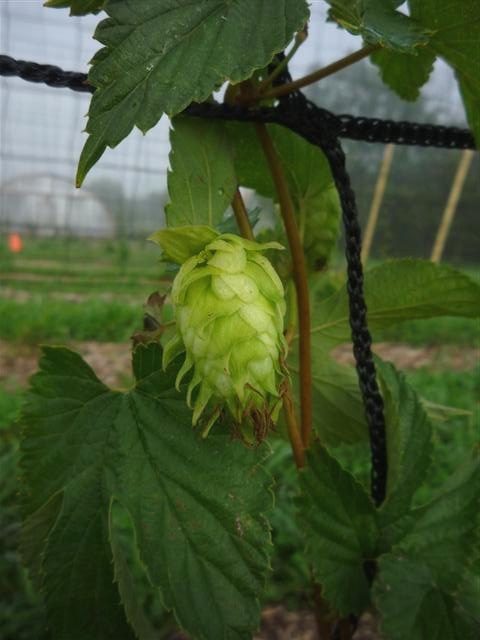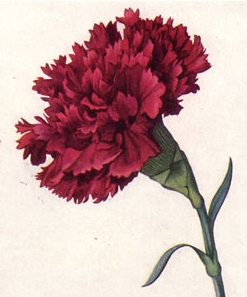Unintended consequences. When doing one thing causes something you didn’t expect. Many unintended consequence stories in biology start with introduced species. I’m going to skip those here. I’ve been thinking about unintended consequences recently while trying to figure out what to do about my hops. You see, hops have a nasty habit of getting powdery mildew. That’s one reason why you don’t see a whole lot of hops growing outside the relatively arid Yakima Valley (75% of US production). We started research on hops this year in relatively un-arid Minnesota, and I don’t want our plants to succumb to the dreaded disease. Because we’re growing varieties that don’t have a lot of resistance, and we can eventually expect to get the disease in this environment, I want to develop a way to manage it effectively so we can still do research. But how do we avoid powdery mildew? A lot of growers use weekly applications of sulfur. It’s a nice fungicide for this purpose, and it’s pretty cheap compared to synthetic fungicides. Great, sign me up for that! Oh by the way, using sulfur early in the season may cause more spider mite problems later in the season compared to using other, more expensive fungicides.1 Oops, unintended consequence.

One of the most famous examples of unintended consequences that I can think of (OK, other than DDT and birds, or introduced species) is from hybrid field corn 40 years ago. Detassling corn for hybrid seed production is a hassle, so a modified corn was developed that didn’t produce pollen. Cytoplasmic male sterility, this technology was called. Perfect! No need to hire droves of unskilled labor to walk every acre of seed corn production fields. Except it turns out that a side-effect of that particular modification made corn especially susceptible to southern corn leaf blight, which damaged a large amount of the corn crop in the early 1970’s. Unintended consequence.
Imagine the florist’s carnation. It’s that flower in shades of white to red that you see on boutonnieres and corsages during homecoming and prom, or alternatively, that flower dyed green for St. Patty’s or blue to match Grandma’s hair. Before breeding for increased longevity / vase life, carnations had a noticeable smell. When breeders ignored fragrance, or possibly even unknowingly selected against fragrance (fragrance may decrease flower longevity), they made carnations that are just kinda pretty looking, and that’s about it. Unintended consequence. Now researchers are trying to figure out how to get fragrance back into flowers (and even into flowers that never had much in the first place).2

Here I will steal from a somewhat confusing speech of recent past, and turn it into somewhat confusing text to fit my story. Unintended consequences are usually a result of ‘unknown unknowns’. We don’t know even know what questions to ask (“Yes, I’m using sulfur to kill powdery mildew. So what?”). Turning an ‘unknown unknown’ into a ‘known unknown’, or something that we know we don’t know but can hopefully find out, takes an open mind, a keen eye, and creativity. Like “hey wait a minute, now that I’m using sulfur on my hops, I seem to have more problems with spider mites. I wonder if there’s a connection…” That’s still unknown, but at least it’s a ‘known unknown’. Turning a ‘known unknown’ into a ‘known’ takes science, and making it widely ‘known’ takes people who keep up to date on science and are good at writing or speaking. Hooray for research and extension!
1 Gent et al. 2009. Effects of powdery mildew fungicide programs on twospotted spider mite, hop aphid, and their natural enemies in hop yards. J. Econ. Entomol. 102(1):274–286.
2Vainstein et al., 2001. Floral fragrance: new inroads into an old commodity. Plant Physiol. 127(4):1383.
A very interesting post. May I suggest that you might want to try the following method to control powdery mildew which the organic gardeners insist works. Your experiments/success/failure would be of great interest.
The formula is 50% cow’s milk of any type to 50% water with a few drops of a surfactant added. Begin spraying before there is any sign of powdery mildew and after every rain. To date I have not heard of any “unintended consequences” using this method.
Nandina,
One experiment at a time! I’m going to use things that are known to work against powdery mildew in hops. I’ve certainly read literature concerning effectiveness of bi-weekly sprays of ~20% milk or weekly sprays of 50% for zucchini squash and pumpkins (Bettiol, 1999; Ferrandino and Smith, 2007), but mold was a problem in the first study with high milk concentrations. Mold is a major defect in harvested hops, I’d like to avoid it (it’s not really a problem on squash leaves, because you’re not selling the leaves!). Other treatments are much more cost-effective where I am (not adjacent to a dairy…), and are known to work on hops, so I’ll stick with those in the early stages of the research. If I eventually want to study hop diseases or fungicides, milk will certainly be one to consider.
Nandina, I did a column on the science behind milk sprays a few years back. You can find it at:
http://www.puyallup.wsu.edu/~linda%20chalker-scott/Horticultural%20Myths_files/Myths/Milk%20and%20mildew.pdf
Along with some colleagues here at UMN I have done some work with milk and blackspot on rose — you can read about it here http://www.extension.umn.edu/projects/yardandgarden/YGLNews/YGLNewsApril12008.html It’s the second to last article.
My mother was from Mississippi and my grandfather worked for the Mississippi Game and Fish Commission. She helped to plant kudzu in the 1930’s to control erosion. There were a few unintended consequences there.
Potassium bicarbonate works very well on mildew. (Green Cure comes to mind as a commercially available form) Sodium bicarbonate reportedly also has some effectiveness. Good article. Interestingly hops itself is one of those unintended consequences as it is somewhat invasive here in WI.
Nick, I did a fairly extensive review on bicarbonates a few years ago. You can find it here: http://www.puyallup.wsu.edu/~linda%20chalker-scott/Horticultural%20Myths_files/Myths/magazine%20pdfs/Baking%20soda.pdf
Hello! Plant and plant products are affected by a large number of plant pathogens among which fungal pathogens. These diseases play a major role in the current deficit of food supply worldwide. Various control strategies were developed to reduce the negative effects of diseases on food, fiber, and forest crops products. Although fungicide treatments are a key component of disease management, the emergence of resistance, their introduction into the environment and their toxic effect on human, animal, non-target microorganisms and beneficial organisms has become an important factor in limiting the durability of fungicide effectiveness and usefulness. I found one great free book – “Fungicides”. This book contains 25 chapters on various aspects of fungicide science from efficacy to resistance, toxicology and development of new fungicides that provides a comprehensive and authoritative account for the role of fungicides in modern agriculture. Book is new and you can read it like I do on online reading platform or just download it on same link here: http://www.intechopen.com/books/show/title/fungicides Cheers!